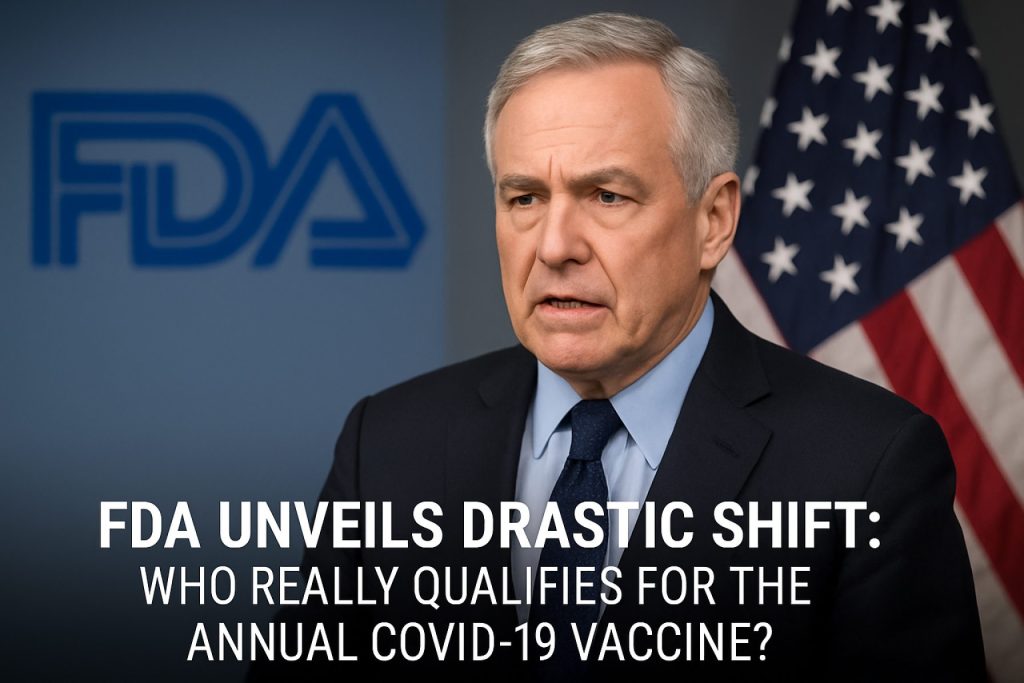
- Annual COVID-19 boosters now limited to adults 65+ and younger people at high medical risk.
- This marks a move away from universal vaccination, aligning U.S. policy with Canada and Australia.
- Change driven by insufficient evidence of benefit in low-risk groups and rising vaccine hesitancy.
- FDA urges larger studies to prove safety and efficacy for broader use, but such trials face challenges.
- Growing mistrust in vaccines could impact overall public health if not addressed with transparency and science.
A bracing wind of change has swept through the corridors of American public health policy as the Food and Drug Administration unveils a new approach: annual COVID-19 vaccines will no longer blanket the entire population. With precision reserved only for the most crucial cases, only adults aged 65 and older, along with children and young adults at heightened medical risk, now stand eligible for the yearly booster.
For millions accustomed to receiving their annual jab, the landscape has changed overnight. Dr. Michael Calderwood, an infectious disease physician at Dartmouth Hitchcock Medical Center, described this shift as America catching up with health trends established in Canada and Australia. “The recommendation isn’t universal, like the flu shot. The debate raging now is about evidence: Do we have enough to justify vaccinating everyone, regardless of age or existing health conditions?” he mused, referencing the heated discussions gripping the medical community.
- Who qualifies now? Only those 65+, or children and young adults with certain underlying health risks
- What’s changing? Annual COVID-19 vaccines will be much less widespread than in previous years
- Why the change? Officials cite insufficient data on benefit in lower-risk groups and growing concerns over public trust in vaccines
The FDA’s cautious stance signals a new era, one where abundant caution rules policy and the lived experience of the last years shapes decisions. Officials urge vaccine manufacturers to launch larger, more robust studies—randomized trials spanning lower-risk groups—to prove safety and efficacy before expanding eligibility. Yet, as Dr. Calderwood points out, such research could demand hundreds of millions of dollars and years of patient observation. Whether pharmaceutical companies are willing to shoulder this burden remains uncertain.
The driving force behind this policy, Calderwood explains, is a rising tide of vaccine hesitancy and confusion. “Vaccine safety isn’t just about the latest shot,” he cautioned. “If public confidence wavers, there’s a risk that trust in all vaccines—including lifesaving standards like those against measles—could erode. Some are already questioning vaccines long proven to protect our communities.”
The road ahead will be shaped by transparency, trust, and science. With regulators prioritizing caution and evidence over routine, Americans face a future where access to the latest COVID-19 protection depends not only on personal preference, but on age, health conditions, and the evolving frontier of public health research.
Shocking Truths: The Real Pros and Cons Behind the FDA’s New COVID-19 Vaccine Policy
-
Pro: Targeted Protection
The new policy by the Food and Drug Administration concentrates annual boosters on older adults and vulnerable groups. This focused approach helps ensure those at highest risk receive priority and resources are allocated efficiently.
-
Pro: Global Alignment
According to experts at Dartmouth Hitchcock Medical Center, this stance brings the U.S. in line with approaches used in countries such as Canada and Australia, promoting international consistency and potentially benefiting public messaging.
-
Con: Limited Universal Access
Younger, healthy adults are now ineligible for annual boosters, which may leave some feeling vulnerable or confused—especially given earlier campaigns encouraging annual vaccination for all.
-
Con: Data Gaps and Delayed Studies
Officials and physicians note the lack of large-scale studies in lower-risk populations. Without robust, randomized trials (which would require significant investment and time), uncertainty remains around the true benefit and risk for broader groups.
-
Controversy: Rising Vaccine Hesitancy
The evolving guidance might contribute to confusion and distrust in vaccines, not just for COVID-19 but also for established vaccinations. Public confidence, as raised by Dr. Calderwood, is now a critical concern.
-
Limitation: Pharmaceutical Investment Uncertain
Moved by official calls for more compelling data, pharmaceutical companies face pressure to fund expensive, extensive studies—yet they may hesitate, leaving future recommendations in limbo.
The Bold Predictions: What’s Next for COVID-19 Vaccination Policy?
-
Selective Vaccination Expansion?
Experts predict that FDA policy will remain focused on high-risk groups for the foreseeable future. However, if vaccine manufacturers provide strong new data through expanded clinical trials, eligibility guidelines may shift again—potentially re-including more young adults or specific occupational cohorts.
-
Growing Influence of Global Standards
The United States is expected to align its approach further with countries like Canada and Australia, maintaining targeted recommendations rather than a universal booster campaign. International monitoring and cooperation will increasingly influence domestic decisions as new variants emerge.
-
Technological Advances and Next-Generation Shots
Pharmaceutical innovation may bring more robust, longer-lasting vaccines or combination shots (COVID-19 plus flu) in coming years, according to discussions among regulators and companies. Such advancements could alter the current restricted eligibility landscape if proven effective in wider groups.
-
Public Confidence Takes Center Stage
Both government agencies and the broader medical community forecast a renewed drive for transparency and public engagement. Restoring and maintaining trust—after a period marked by skepticism—will be crucial for the future of all immunization programs in the U.S.
-
Policy Reevaluation Timeline
Look for annual or even biannual policy reviews from the Centers for Disease Control and Prevention and other major agencies as new trial data and epidemiological patterns emerge. The COVID-19 vaccine landscape could shift quickly if unexpected outbreaks or highly transmissible variants are identified.



